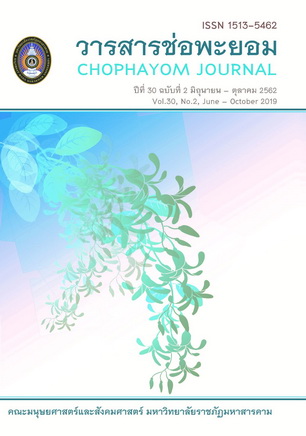Thai Special Economic Zone and Economic Border : Case Study of Wan Yai District, Mukdahan Province
Keywords:
Special Economic Zone, Wan Yai District, Mukdahan ProvinceAbstract
The research was highlighted to Special Economic Zone and Economic Border: Case Study of Wan Yai District, Mukdahan Province. The objectives were: 1) To study the potential of economic and tourism management in this border. 2) To analyse the special economic zone of this border with SWOT method. The qualitative research focused on content analysis and field survey. Moreover, the samplings were conducted to District Chief, Deputy District Chief, Senior Deputy District Chief, Subdistrict Headman, Village Headman, resort entrepreneurs, tourists and villagers, etc. The results were found: 1) The potential of economic border management revealed that most people worked argriculture, domestic animals and fishing. In terms of tourism, this district is also located in middle zone and connected to others tourist attractions. 2) According to SWOT, the strength found that there are a lot of transport routes towards Wan Yai district. Additionally, there are many varieties of tourists attrations in this local. Nevertheless, natural disasters become both a major obstacle and the lack of skilled labours. Stimutaneously, the villagers do not understand enough about this project from the public relations of the government. At present, the high speed train become a major opportunity as center of logistic in this region. Due to geography, Wan Yai is between Mueang district of Mukdahan and That Phranom district, Nakhon Phanom province. It is 33 km apart from Mukdahan Mueang district. Furthermore, this border faces to Xainabouli district, Savanankhet province, The Lao People’s Democratic Republic (LPDR) by the frontier of Mekong River. In conclusion, the cultural and ecotourism development are the most significant of the economic border management. In addition, the development of SMEs also help the villagers to increase their sustainable revenues. Keywords : Special Economic Zone, Wan Yai District, Mukdahan Province
References
กลุ่มงานข้อมูลสารสนเทศและการสื่อสาร สำนักงานจังหวัดมุกดาหาร.(2562). การเดินทางสู่จังหวัดมุกดาหาร.สืบค้นเมื่อ 1 ธันวาคม 2561, จาก https://www.mukdahan.go.th/gandurntang.htm.
จามะรี เชียงทอง และคณะ. (2560). รัฐ ความสมัยใหม่และพื้นที่หลังสมัยใหม่: การจัดระเบียบพื้นที่ชายแดน.เชียงใหม่: หจก. วนิดาการพิมพ์เดลินิวส์. เขตศก.พิเศษมุกดาหาร ประตูชายแดนอินโดจีน. ฉบับวันที่ 20 พฤษภาคม 2559. สืบค้นเมื่อ 1 ธันวาคม 2561, จากhttps://www.dailynews.co.th/economic/398589
ปิ่นแก้ว เหลืองอร่ามศรี.(2561). หลังเขตเศรษฐกิจพิเศษ. เชียงใหม่: กองทุนพัฒนาวิชาการ คณะสังคมศาสตร์ มหาวิทยาลัยเชียงใหม่
ฝ่ายนโยบายและแผน สำนักงานอุตสาหกรรมจังหวัดมุกดาหาร.(2561).เขตพัฒนาเศรษฐกิจพิเศษมุกดาหาร. สืบค้นเมื่อ 1 ธันวาคม 2561, จาก https://www4.fisheries.go.th/local/file_document/20170220153716_file.pdf
ศูนย์ข่าวกระทรวงพาณิชย์.(2561). มุกดาหารชูจุดแข็งด้านโลจิสติกส์ ประตูตะวันออกสู่อาเซียนพลัส นำยุทธศาสตร์ท่าเรือบก มากระตุ้นนักลงทุนในกลุ่มอินโดจีน. สืบค้นเมื่อ 1 ธันวาคม 2561,จาก https://www.moc.go.th/index.php/moc-news/2015-10-19-04-33-08/item/%E0%B8%A1%.html,
ศูนย์ข้อมูลข่าวสารอาเซียน กรมประชาสัมพันธ์. (2558). เขตเศรษฐกิจพิเศษ พิเศษจริงหรือ....? สืบค้นเมื่อ 2 สิงหาคม 2562, จาก https://www.aseanthai.net/ewt_news.php?nid=740&filename=index
ศูนย์บริการข้อมูลอำเภอ. (2561). ข้อมูลทั่วไปของอำเภอหว้านใหญ่. สืบค้นเมื่อ 1 ธันวาคม 2561,จาก https://www.amphoe.com/menu.php?mid=1&am=469&pv=42
สถาบันพัฒนาองค์กรชุมชน.(2561). ข่าว: เขตเศรษฐกิจพิเศษโอกาสหรือภัยคุกคาม ชุมชน. สืบค้นเมื่อ 1 ธันวาคม 2561,จาก https://www.codi.or.th/2015-08-04-11-01-52/12773-2015-04-05-14-10-59
สถาบันระหว่างประเทศเพื่อการค้าและการพัฒนา.(2558).แนวทางและมาตรการเพื่อการพัฒนาเขตเศรษฐกิจพิเศษบริเวณพื้นที่แนวชายแดนของไทย.สืบค้นเมื่อ 9 มิถุนายน 2562 ,จาก https://thailand.opendevelopmentmekong.net/th/topics/special-economic-zones/ สำนักงานยุทธศาสตร์และการวางแผนพัฒนาพื้นที่ สำนักงานคณะกรรมการพัฒนาเศรษฐกิจ.(2559). เขต
พัฒนาเศรษฐกิจพิเศษตามแนวชายแดน. สืบค้นเมื่อ 9 มิถุนายน 2562,จากhttps://data.opendevelopmentmekong.net/dataset/9b5bd23c-963d-42bf-b553-cfbea97a3771/resource/ede372ea-b639-4f1d-901e-bea30bdd4db3/download/4border-special-economic-zones-development.pdf
Baissac, C. (2011). Brief History of SEZs and Overview of Policy Debates. In T. Farole, ed. Special Economic Zone in Africa: Comparing Performance and Learning from Global Experiences. Washington, Dc: The World Bank.
Farole, T. and G. Akinci, eds. (2011). Special Economic Zone. Farole, T. and G. Akinci,eds. Special Economic Zones Progress, Emerging Challenges, and Future Directions. Washington, Dc: The World Bank.
Pinyochatchinda, Supaporn and Johan Walsh. (2015). “The Role of SEZs in Thailand’s Regional Economic Development,” The Business and Management Review 6(4) August: pp.199- 212.
Walsh, John. (2015).”The Special Economic Zones of the Greater Mekong Subregion: Land Ownership and Social Transformation,” Land Gabbing, Connect and Agrarian-Environmental Transformations: Perspectives from East and Southeast Asia. Chiang Mai: Chiang Mai University.




